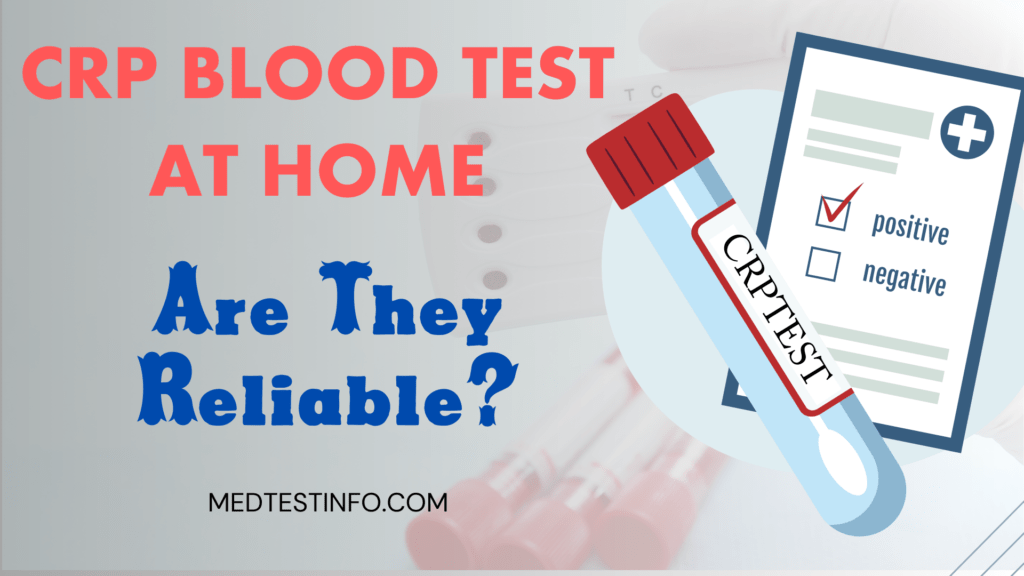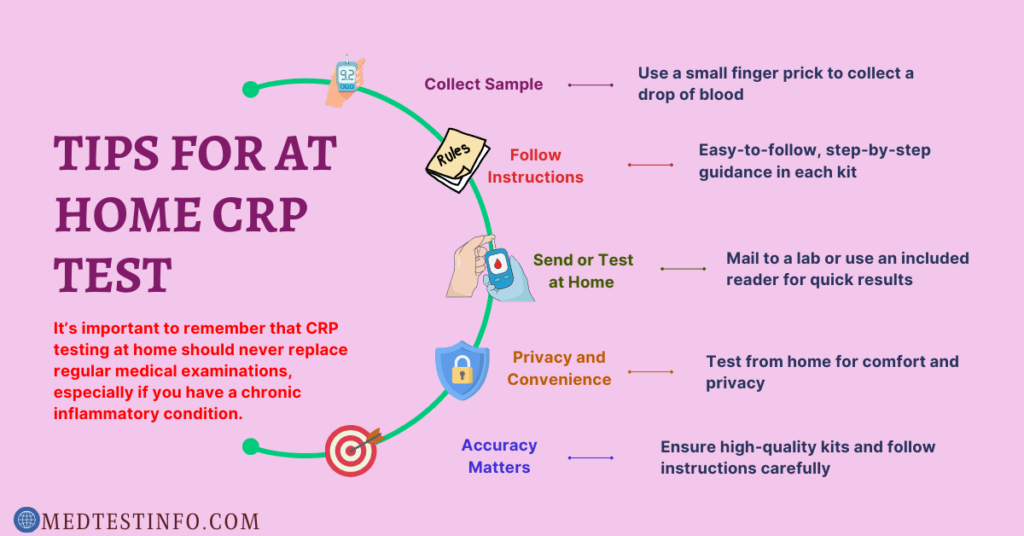
Overview
At-home health testing is growing more popular than ever, particularly among people who prefer the ease of monitoring their health from home. Among these possibilities, the at-home CRP test has gained popularity as a method of monitoring inflammation without requiring a lab visit. C-reactive protein (CRP) levels in human blood are:
- Important indicators of inflammation.
- Helping to detect disorders such as infections.
- Autoimmune diseases.
- Even heart disease risk.
However, is our at-home CRP testing accurate? This article will examine what a CRP test evaluates, how it works from home, how reliable it is, and how to interpret the data successfully.
What Is The CRP Test?
A CRP test, also known as a C-reactive protein blood test, determines the amount of CRP, a protein produced by the liver in reaction to inflammation. Inflammation is part of the body’s immunological response and can be caused by various disorders, including infections and autoimmune diseases.
So, what blood test is CRP? It’s a simple blood test that shows CRP levels in the body, allowing doctors to evaluate if there’s an inflammatory process at work. When you obtain your blood report, your doctor may examine the CRP levels to determine whether further investigation or treatment is required. A CRP blood test at home may allow you to check these levels more regularly, potentially detecting inflammation early and triggering quick medical attention.

How Does An At-Home CRP Test Work?
Using an at-home CRP test kit is simple. It usually involves a little blood sample collected via a finger prick. These kits are intended to be user-friendly and often include step-by-step instructions, making the testing process accessible to those without medical experience.
After collecting your sample, most kits allow you to submit it to a lab for analysis. However, others may provide rapid findings via a reader device supplied with the kit. This method of CRP testing at home is convenient and private, allowing you to avoid going to a medical center. While CRP blood tests can be performed at home, their accuracy dramatically depends on the test kit’s quality and attention to instructions.
Are At-Home CRP Tests Accurate?
This raises the question of whether at-home CRP tests are accurate. These tests are generally reliable, but they do have limitations. Laboratory tests are considered the gold standard since they are performed under strictly controlled conditions and assessed by qualified medical personnel. The CRP blood test at home may estimate your CRP levels. However, factors such as sample contamination, human mistakes, or differences in quality between brands may impact the results.
It’s important to remember that CRP testing at home should never replace regular medical examinations, especially if you have a chronic inflammatory condition. However, an at-home test might be helpful for general monitoring and identifying inflammatory levels that may necessitate additional testing or consultation with your healthcare physician.

Interpreting The CRP Test Results
Understanding your at-home CRP test findings is essential for making informed health decisions. Typically, an average CRP blood test level is less than one mg/L, with levels between 1 and 3 mg/L indicating moderate risk and levels above three mg/L showing increased inflammation that may necessitate medical treatment.
Knowing what these levels signify for your health is useful when you receive your CRP results. Elevated CRP levels may indicate an infection, chronic inflammatory diseases, or other underlying health concerns. Although CRP blood test results can vary, it is critical to recognize that CRP is only one component of a larger health picture. Consult a doctor about your results, whether from a home test or a lab, to better understand your condition.
Limitations Of At-Home CRP Testing
While an at-home CRP test is a convenient approach to tracking inflammation, it’s essential to understand its limits. These tests may provide more detail than a lab-based CRP blood test, particularly for high-sensitivity CRP (hs-CRP). However, at-home tests may only include some markers seen in total blood panels, resulting in a less complete health picture.
Improper sample collection, testing outside of a lab setting, and kit quality all impact the accuracy of at-home CRP test findings. If you see exceptionally high or low readings, talk to your doctor about getting a lab-based follow-up test to confirm your findings.
Conclusion
An at-home CRP test is convenient and generally reliable for tracking inflammation markers such as C-reactive protein. At-home CRP tests are beneficial for initial or continuous personal monitoring but are not diagnostic tools. They provide helpful information but need more depth of lab tests. If your findings show high CRP levels or if you have any specific concerns, speak with your doctor. In some circumstances, a lab-based CRP blood test may provide a more complete health picture.
An at-home CRP test can help you take control of your health by monitoring key indicators. However, your CRP in blood report must be interpreted within the larger medical context to make appropriate health assessments. This strategy guarantees that you use CRP testing as a helpful health tool while maintaining a balanced and professional attitude toward its position in your healthcare practice.
Frequently Asked Questions (FAQs)
An at-home CRP test can easily and quickly check the amounts of C-reactive protein (CRP) in your blood. CRP is a substance that the liver produces when there’s inflammation in the body. High CRP levels can indicate inflammation due to infections, ongoing health issues like arthritis or lupus, or even heart-related conditions. This test allows people to keep track of their inflammation levels right from home, making it easier and more convenient than going to a clinic or lab.
At-home CRP tests are easy to use and provide quick results. The test typically includes:
Gently pricking your finger with a lancet to gather a tiny drop of blood.
Gently place the sample onto a test strip or into the collection tube included in the kit.
Some kits offer quick results with a color-coded strip, while others require you to send the sample to a certified lab for analysis. Depending on your test type, you’ll get results in just a few minutes or, at most, a few days. The kit has clear instructions to help you use it accurately and efficiently.
At-home CRP tests are typically trustworthy and apply methods that are similar to those used in clinical labs. These are meant for initial screening rather than in-depth diagnosis. Even though many tests provide reliable results, incorrect sample collection or mishandling can affect their accuracy. To make sure everything works as it should:
Choose reliable and certified brands for your test kit.
Please take the time to follow the instructions included in the kit.
If you get results that are higher than normal or seem unusual, it’s a good idea to contact a healthcare professional for more testing or to confirm what those results mean.
An at-home CRP test is beneficial if you:
Experiencing symptoms of chronic inflammation like fatigue, joint pain, and swelling.
If you’re dealing with conditions such as rheumatoid arthritis, lupus, or inflammatory bowel disease, it’s essential to monitor your inflammation levels.
If you’re worried about your heart health, it’s essential to know that higher CRP levels may be associated with inflammation in the cardiovascular system.
Looking to monitor how healthy lifestyle changes like diet and exercise, or anti-inflammatory treatments, are working.
Doing a CRP test at home is a fast way to better understand your health and helps you decide when it might be time to seek medical guidance.
If your at-home CRP test shows higher levels, try not to worry too much. There are several reasons why CRP levels might be elevated, such as:
Infections, whether they’re bacterial or viral.
Chronic inflammatory diseases such as rheumatoid arthritis, lupus, and various autoimmune conditions.
Factors related to our daily lives, like unhealthy eating, smoking, or being overweight.
Cardiovascular risks due to inflammation in blood vessels.
It’s essential to reach out to a healthcare provider for guidance. They suggest extra tests, like a complete blood count (CBC) or imaging studies, to help uncover the root cause. With your results, they can create a tailored treatment plan to help reduce inflammation and support your overall well-being.


